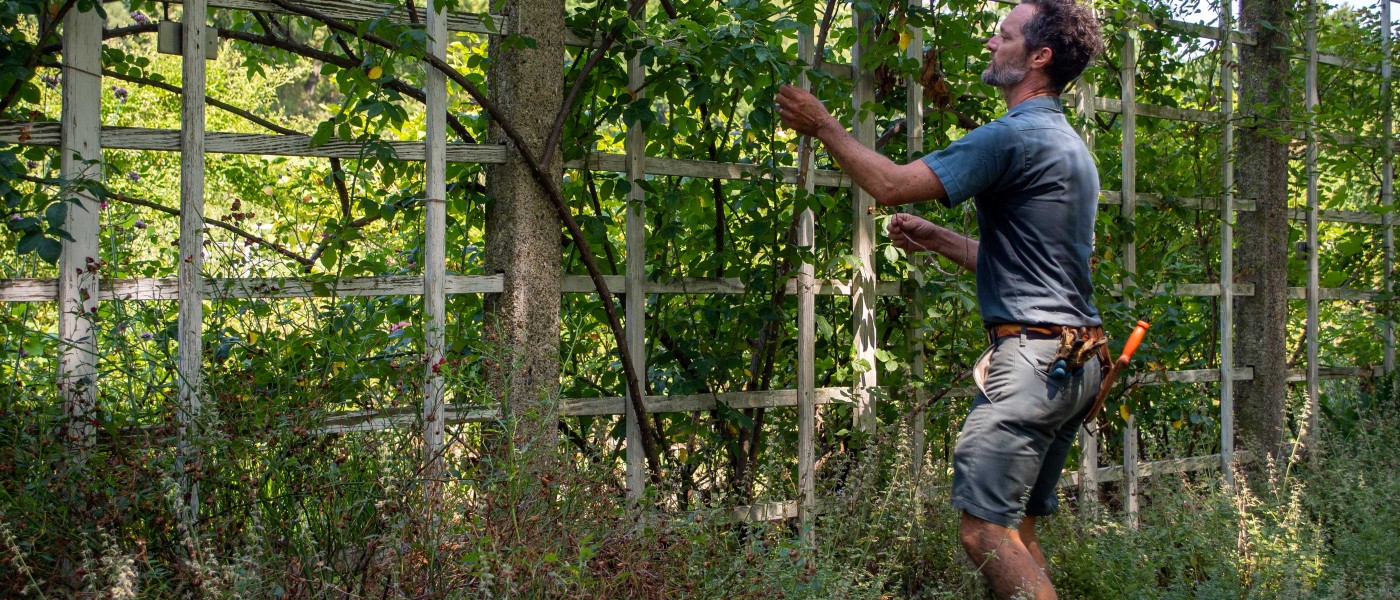A Cane-Do Attitude in the Rose Garden
In winter, when the Cranford Rose Garden is bare of the foliage and blooms that cover the hardscape in June, the architecture and structure persist. Take notice of the shapes and sculptural treatments of the winding canes of rose ramblers, the once-blooming roses that grow new canes throughout the growing season. Like Rosa ‘Ethel,’ and ‘Apple Blossom,’ which seem to float along the posts and chain swags, their canes are thinner and more pliable than those of climbing roses.
Gardener William Wallace, who curates the Rose Garden, strives for a balance of casual and formal, wild and tame. He achieves this in part with a special technique of tying up rose canes, which provides more visual appeal for visitors in winter, when the canes are bare, and in spring, as they leaf out.
It’s a process both technical and artistic, and one he’d begun dabbling in after taking a house and garden tour through southern England with his husband in the summer of 2017. He visited Sissinghurst Castle Garden, the former estate of Vita Sackville West and Harold Nicolson known for its many themed garden “rooms” that comprise the landscape. “I can’t stress enough the beauty of it,” says Wallace.
Inspired by his travels, Wallace then applied to and received the prestigious Chanticleer Scholarship in Professional Development. In January 2019, Wallace went back to Sissinghurst and their much-admired rose garden to observe and hone their unique rose-tying technique—sometimes called “living lace,” but most often referred to as “the Sissinghurst method.”
The Sissinghurst method is based around the idea of exposing or incorporating more of the rose canes into the overall structure—say, the fencing, or an arbor. But for Wallace, it’s also about creating a work of art. Take the Rosa ‘Bobby James,’ for example, a rambler that grows along one of the Rose Garden’s posts and swag chains. Instead of tying the canes tightly to the structure, Wallace spread them out in a fan shape. He made loops and soft bends with the lateral canes, retying them onto themselves with garden twine. The effect is significant.
“You get more of a ‘cloud’ of flowers, as opposed to a line of them,” Wallace explains. “I’ve made it something much more massive than the hardscape alone.”
There’s a notion that roses must look tidy and restrained. But the Sissinghurst method lends itself to whimsy and experimentation. “I just really want to show visitors that ramblers can be a lot of fun,” says Wallace, “and that they can do this in their own home.”
Some of his top tips: Do the tying in the winter months, when the canes have lost their foliage. Then remove the old canes and tie up the new growth with twine, in any way you like. “With the vigorous rambler, you’re not going to kill it,” Wallace says. “It’s going to look good.” Wallace notes that Garden volunteers who help him with the rose tying often come up with a lovely cane structure he hadn’t thought of before.
One of Wallace’s biggest takeaways is to have fun with it, because there’s no one right way to tie up every single rose. “You work with what you have, and you don’t stress out about doing it incorrectly,” Wallace explains. “The rose needs to speak for itself.”



